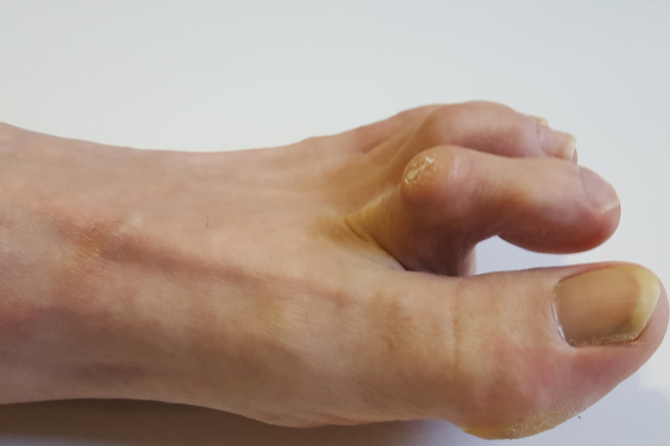
Crooked Toes and Why they Need to be Fixed
It’s estimated that over 20% of the US population suffers from toe deformities or “crooked” toes. There are many types of crooked toes including hammertoe, mallet toe, and claw toe. Additionally, toes may be pushed sideways, overlapping with the next toe, or they might rotate from their original position.
Crooked toes may not be bothersome on their own, but will often result in additional symptoms such as corns, calluses, or open sores forming on the top of the toe. As toes become more bent, it will become more and more difficult to find comfortable shoes. Eventually, you may have difficulty moving the toe at all. If your crooked toes are leading to other issues, it’s time to get them fixed.
Types of crooked toes include:
Hammertoe
A hammertoe is an abnormal bend at the proximal interphalangeal (PIP) joint of any toe, though it is most common in the second, third, and fourth toes. When the toe joint is flexed (bent) upward for a long period of time, the muscles on the top and bottom of the toe become imbalanced, leading to a permanent bend.
Mallet Toe
A mallet toe is an abnormal bend at the distal interphalangeal joint (DIPJ) which sits closest to the toenail. This bend is also the result of a muscle imbalance, this time affecting the flexor digitorum longus (FDL) muscle which runs from the shin to your toes (excluding the big toe) and allows you to curl your toes. If this muscle tightens, it can cause a permanent bend in the joint.
Claw Toe
Claw toe occurs when both joints in the toe become bent, turning the toe under in a claw-like shape. This type of crooked toe can be very bothersome as it will rub on the top and dig into the bottom of regular shoes.
Overlapping Toe
Sometimes toes might be squeezed together from the sides, causing one toe to migrate on top of or underneath an adjacent toe. This can happen due to heredity or can be caused by the presence of a hammertoe or bunion.
Adductovarus Toe
Usually seen on the fourth or fifth toe, this condition is characterized by a bending of the toe toward one side of the foot. This may push the sides of toes together where they can rub against one another or push the outer toe against the sides of your shoes, causing discomfort or calluses. This is also caused by a muscle or tendon imbalance, except the toe is pulled at an oblique angle.
Why fix a crooked toe?
Crooked toes may not seem like a big deal, but trust us, they are. Corns and calluses can become bothersome. Shoe shopping is a nightmare. For diabetics, rubbing on the insides of shoes means calluses can turn into sores which are difficult to heal. Over time, a crooked toe will become rigid and unable to return to its normal position.
Your toes are a critical part of stepping and running. A crooked toe means the weight distribution of your foot is disrupted and pressure that used to be evenly distributed is absorbed by other parts of the foot. This could lead to pain and other debilitating problems.
How to fix crooked toes
If your crooked toe is still flexible, it’s possible that lifestyle changes will prevent further deformity. Shoe changes are the most important factor. Choose shoes that are wider in the toe box and a little bit longer. Avoid high heels and shoes that squeeze the toes together. Your podiatrist may also recommend a splint that will hold a flexible toe in a straight position.
Along with shoe changes, it’s important to stretch and flex the toes to keep your muscles strong and balanced. Place a towel on the ground and use your toes to crumple it. Manually stretch your toes by pulling them gently outward and apart. A physical therapist can help design a toe exercise program specifically for your needs.
In cases where the toe has become completely rigid, a surgical solution may be necessary. Your FAAWC surgeon will perform a small procedure in which they release the contracted muscle or tendon and straighten the toe. This is generally done as an outpatient procedure with a minimal recovery of several weeks.
Leave a reply